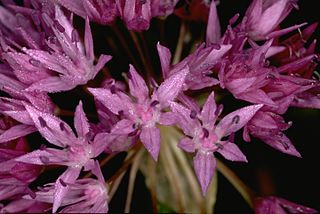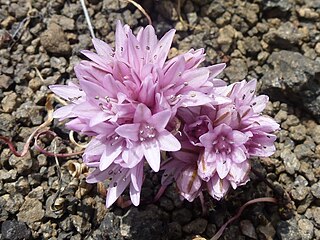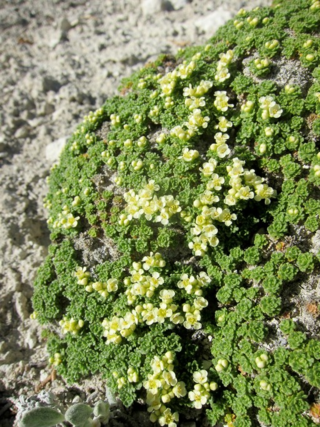
Allium validum is a species of flowering plant commonly called swamp onion, wild onion, Pacific onion, or Pacific mountain onion. It is native to the Cascade Range, the Sierra Nevada, the Rocky Mountains, and other high-elevation regions in California, Oregon, Washington, Nevada, Idaho and British Columbia. It is a perennial herb and grows in swampy meadows at medium and high elevations.

Allium cernuum, known as nodding onion or lady's leek, is a perennial plant in the genus Allium. It grows in open areas in North America.

Allium textile is a common species of wild onion found in the central part of North America.

Allium acuminatum, also known as the tapertip onion or Hooker's onion, is a species in the genus Allium native to North America.

Cleomella refracta, common names jackass clover or spectacle fruit, is a species of flowering plant in the cleome family, Cleomaceae. It is native to northwestern Mexico and the southwestern United States, particularly Chihuahua, Sonora, trans-Pecos Texas, New Mexico, Arizona, Utah, Nevada and California. The species occurs in sandy flats, desert scrub and disturbed sites such as roadsides.

Allium atrorubens is a species of wild onion known by the common name dark red onion. This plant is native to the southwestern United States where it grows in the sandy soils of the Mojave Desert, the Great Basin and higher-elevation deserts in Nevada, eastern California southwestern Utah, northwestern Arizona.

Allium lemmonii is a species of wild onion known by the common name Lemmon's onion, named for botanist John Gill Lemmon (1831–1908). It is native to the western United States, at elevations of 1200–1900 m in the Great Basin of Utah, Nevada, northern and eastern California, eastern Oregon, southwestern Idaho.

Allium nevadense is a species of wild onion known by the common name Nevada onion. It is native to the western United States where it grows in sand and rocky soil at elevations of 1400–1700 m. The species is widespread in Utah, Nevada and southern Idaho, and has been reported also from southeastern California, northwestern Arizona, western and central Colorado and eastern Oregon.

Allium parvum is an American species of wild onion known by the common name small onion. It is native to the western United States where it is a common member of the flora in rocky, dry areas in mountainous areas, especially in talus at elevations of 1,200–2,800 m (3,900–9,200 ft). It is widespread in California, Nevada, Oregon and Idaho, and also reported from western Utah and from extreme southwestern Montana.
Allium punctum is a species of wild onion known by the common name dotted onion or Modoc onion. It is native to the western United States in and around the Modoc Plateau in northeastern California, northwestern Nevada, and southeastern Oregon. It is uncommon, growing in volcanic flatlands created by old lava flows.
Toiyabea granitica, common names granite serpentweed and Lone Mountain serpentweed, is a rare endemic plant species known only from the east side of Lone Mountain in Esmeralda County, Nevada, about 20 km west of Tonopah. It grows there in the crevices of granitic outcrops.
Caulanthus barnebyi, the Black Rock wild cabbage, is a plant species endemic to a small region in the US State of Nevada. It is known only from the Black Rock Mountains in Humboldt and Pershing Counties in the northwestern part of the state. It grows on dry, rocky slopes and outcrops at elevations of 4,300–4,900 feet (1,300–1,500 m).

Lepidium nanum, the dwarf pepperweed, is a plant species native to the US states of Nevada and Utah. It is known from four counties in Nevada but only one in Utah. It occurs in open, sunlit areas in the desert, often with gypsum, limestone, quartzite or chalky soils.
Thelypodium laxiflorum, the droopflower thelypody, is a plant species native to the southwestern United States. It grows in open, rocky places on slopes and cliff faces, usually in pinyon-juniper woodlands at elevations of 4,900–10,200 feet (1,500–3,100 m). It has been reported from Utah, western Colorado, southern Nevada, northwestern Arizona, and northwestern New Mexico.

Allium aaseae, the Southern Idaho onion or Aase's onion, is a plant species endemic to southwestern Idaho. It has been reported from 6 counties: Elmore, Ada, Boise, Gem, Payette and Washington.

Allium brandegeei is a plant species native to the western United States. It has been reported from western Colorado, Utah, Idaho, eastern Oregon, Park County, Montana and Elko County, Nevada.

Allium geyeri or Geyer's onion is a North American species of onion widespread in the western United States and in western Canada. It is found in the Rocky Mountain States from New Mexico to Idaho, Great Basin, the Pacific Northwest, Texas, South Dakota, Arizona, Manitoba, British Columbia, Alberta and Saskatchewan.

Allium macropetalum, the desert onion, is a species of wild onion native to the desert regions of southwestern United States and northwestern Mexico. It is known from desert plains and hills in Sonora, Arizona, Utah, Colorado, New Mexico, and Texas, at elevations up to 2500 m.

Allium simillimum, the simil onion, or dwarf onion, is a plant species native to Idaho and Montana. It grows on sandy soils at high elevations in the mountains, 1800–3400 m.

Allium brevistylum is a plant species native to the western United States. It grows in meadows and along stream banks high in the mountains of Colorado, Utah, Wyoming, Montana and Idaho, at elevations of 2200–3400 m.
















